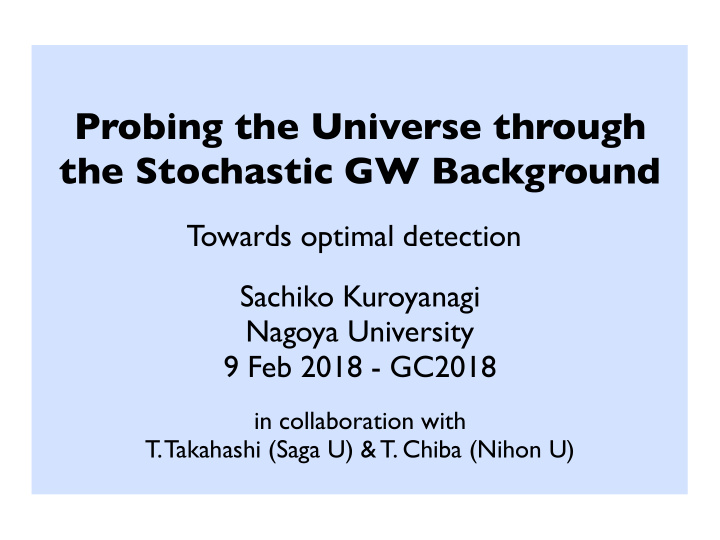



Probing the Universe through the Stochastic GW Background Towards optimal detection Sachiko Kuroyanagi Nagoya University 9 Feb 2018 - GC2018 in collaboration with T. Takahashi (Saga U) & T. Chiba (Nihon U)
Stochastic GW background strain time [s] random phase & no directional dependence ∆ T < f − 1 ・ Overlapped astrophysical GWs ・ GWs from the early Universe
Sensitivity curves for GW background Inflation
Astrophysical GW background BH binaries NS binaries WD binaries Inflation POPIII supernovae
Cosmological GW background Cosmic strings G μ ~10 -12 Preheating T~10 9 GeV Inflation Electroweak phase transition T~100GeV
How to detect a stochastic background LIGO-India multiple detector network KAGRA VIRGO LIGO Cross Correlation detector1 detector2 s 2 ( t ) = h ( t ) + n 2 ( t ) s 1 ( t ) = h ( t ) + n 1 ( t ) s: observed signal h: gravitational waves n: noise no correlations → 0 GW signal (for detector at the same location)
Ref. Allen & Romano, PRD 59, 102001 (1999) Optimal filtering filter function Signal in Fourier space Noise in Fourier space Signal-to-noise ratio Maximized when :noise spectrum :overlap reduction function (determined by detector positions)
“Upper Limits on the Stochastic Gravitational-Wave Background from Advanced LIGO's First Observing Run”, LIGO & Virgo Collaboration, PRL. 118, 121101 (2017) We need template = spectral shape parametrized by a single power law f ref = 25Hz
f * ~ energy scale of the event f Ω GW* f * n GW2 n GW1 Ω GW n GW1 =3, n GW2 : exponential cutoff n GW1 =3, n GW2 =-2 Idea Many models of stochastic background predict a peaked shape Is broken-power law better for fitting? example ・ Phase transition ・ Preheating Spectral shape is important information to identify generation mechanism
Brito et al. PRL 119, 131101 (2017) “Stochastic and resolvable gravitational waves from ultralight bosons” Example GWB from superradiant instabilities (Ultralight scalar fields around spinning black holes)
f * =52[Hz] Ω GW* = 1.43×10 -7 n GW2 =-0.3 n GW1 =4.7 Ω GW* (at 25Hz) = 1.25×10 -8 n = 2.3 Template fitting 10 -6 ← single power-law fitting 10 -7 ← broken power-law fitting Ω GW ← true signal 10 -8 10 -9 10 1 10 2 f [Hz] LIGO+ VIRGO+KAGRA design single: SNR=70.7, δχ 2 =1440 broken: SNR=80.0, δχ 2 =47.4 ~10% loss of signal-to-noise ratio → (perfect template: SNR=80.3) δχ 2 shows single is bad fit
n GW1 >0 n GW1 >0 f n GW1 <0 n GW2 >0 Ω GW f n GW1 <0 n GW2 <0 Ω GW f Ω GW n GW2 >0 n GW2 <0 Ω GW f δχ 2single - δχ 2broken large δχ 2 small δχ 2 large δχ 2 Broken power-law improves fitting → better measurement of shape
n GW2 = -2.0 ± ? n GW1 = 3.0 ± ? n GW2 = -2 How accurately can we measure the tilt? Prediction by Fisher analysis for n GW1 = 3 LIGO O1 constraint 10% error 10% 50% error 50% LVK design 1. Large amplitude is necessary to measure the tilt 2. The error also depends on the peak position
How accurately can we measure the tilt? σ n 1 ,n 2 ∝ SNR -1 � 1 / 2 integration in frequency domain ∝ 10 π 2 f 5 P 1 ( | f | ) P 2 ( | f | ) Sensitivity curve 3 H 2 T ∆ log f γ 2 ( | f | ) 0 SNR>2 for in each frequency bin Δ logf = 0.1 10 -6 10 -6 10 -7 10 -7 Ω GW Ω GW 10 -8 10 -8 f * f * 10 -9 10 -9 10 1 10 2 10 1 10 2 f [Hz] f [Hz] n GW1 is determined accurately n GW2 is determined accurately
f n GW2 >0 f n GW1 <0 n GW2 <0 n GW2 <0 Ω GW f n GW1 >0 Ω GW Ω GW n GW1 <0 n GW2 >0 Ω GW f n GW1 >0 General expectation 10% error 50% error Larger amplitude increases the area σ n 1 ,n 2 ∝ SNR -1 ∝ Ω GW*-1
Peak frequency dependence 50% 10% 50% error 50% 50% n GW2 is determined accurately n GW1 is determined accurately
Discussion • Fitting by broken power-law is more time consuming single: 1free parameter (n GW ) broken: 3 free parameter (n GW1 , n GW2 , f * ) • Strategy? 1. GW search by single power-law 2. Fitting by broken power-law High SNR detection is necessary for the 2nd step • Same discussion holds for DECIGO → More chance to detect GW background
Summary • Detection of a stochastic GW background is the next challenging step for GW science • It’s searched by matched filtering so we need to prepare templates (= spectral shape) • We made quantitive estimations on broken-power law fitting and found that it dramatically improves δχ 2 • We also made estimation on how accurately the spectral told can be determined. Precise fitting of spectral shape would help to identify the generation mechanism
Recommend
More recommend